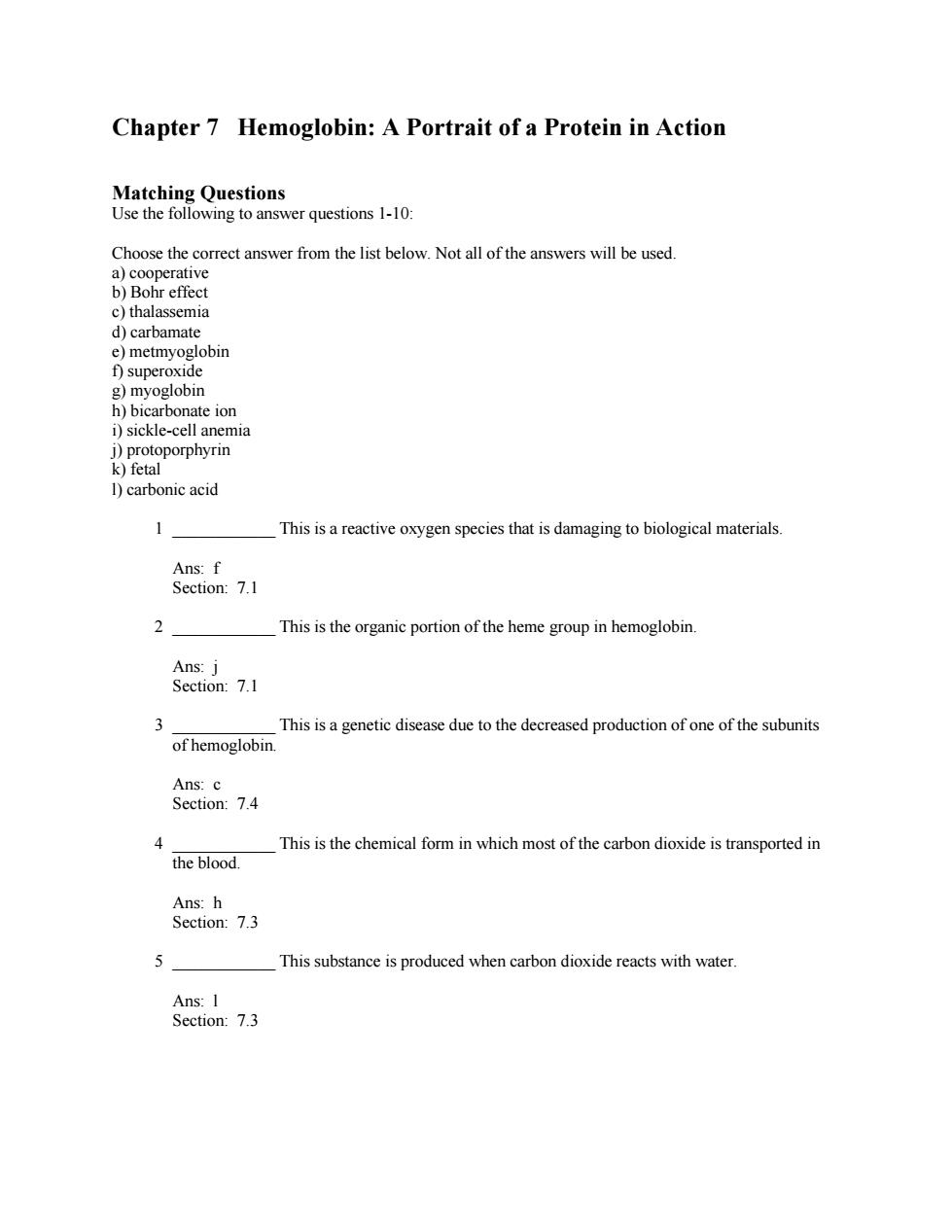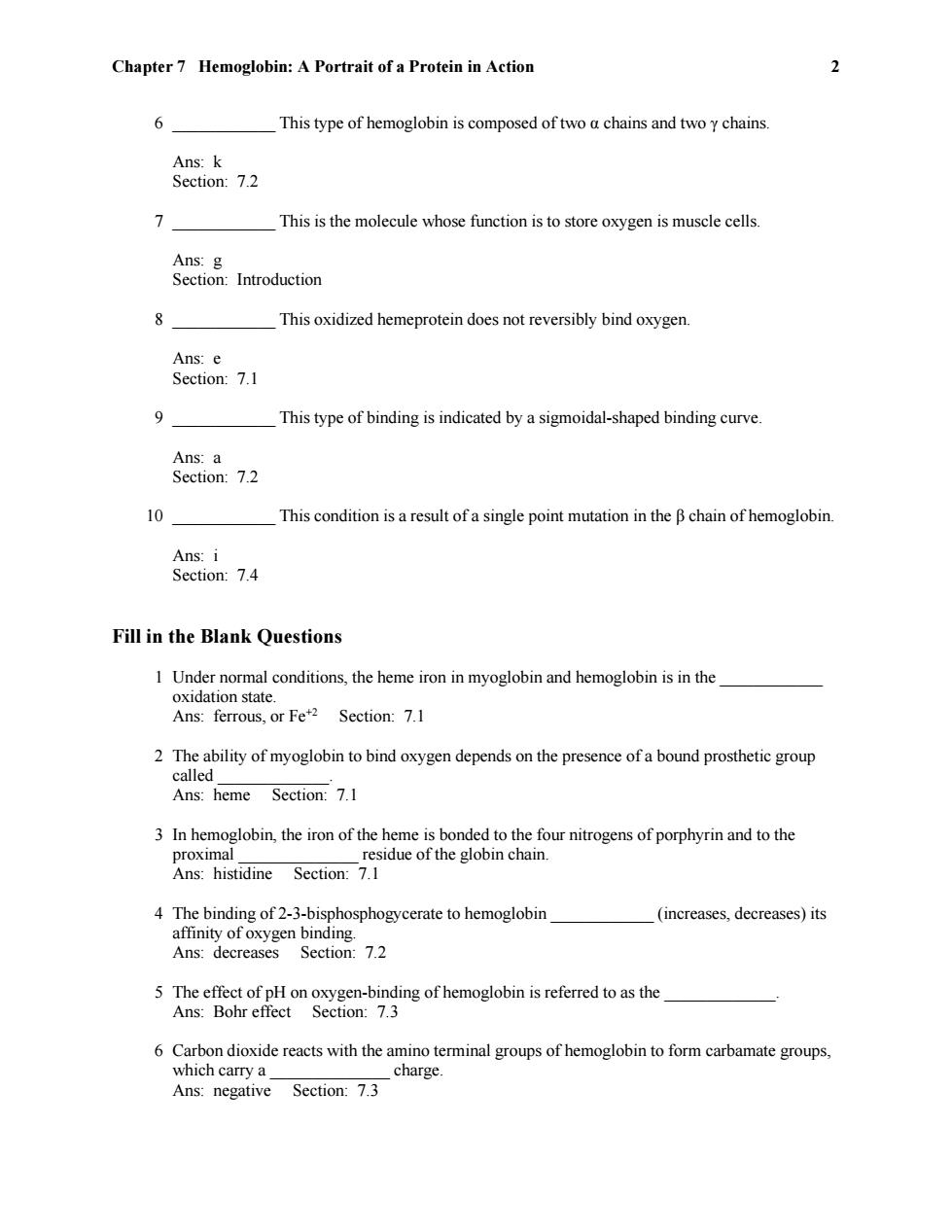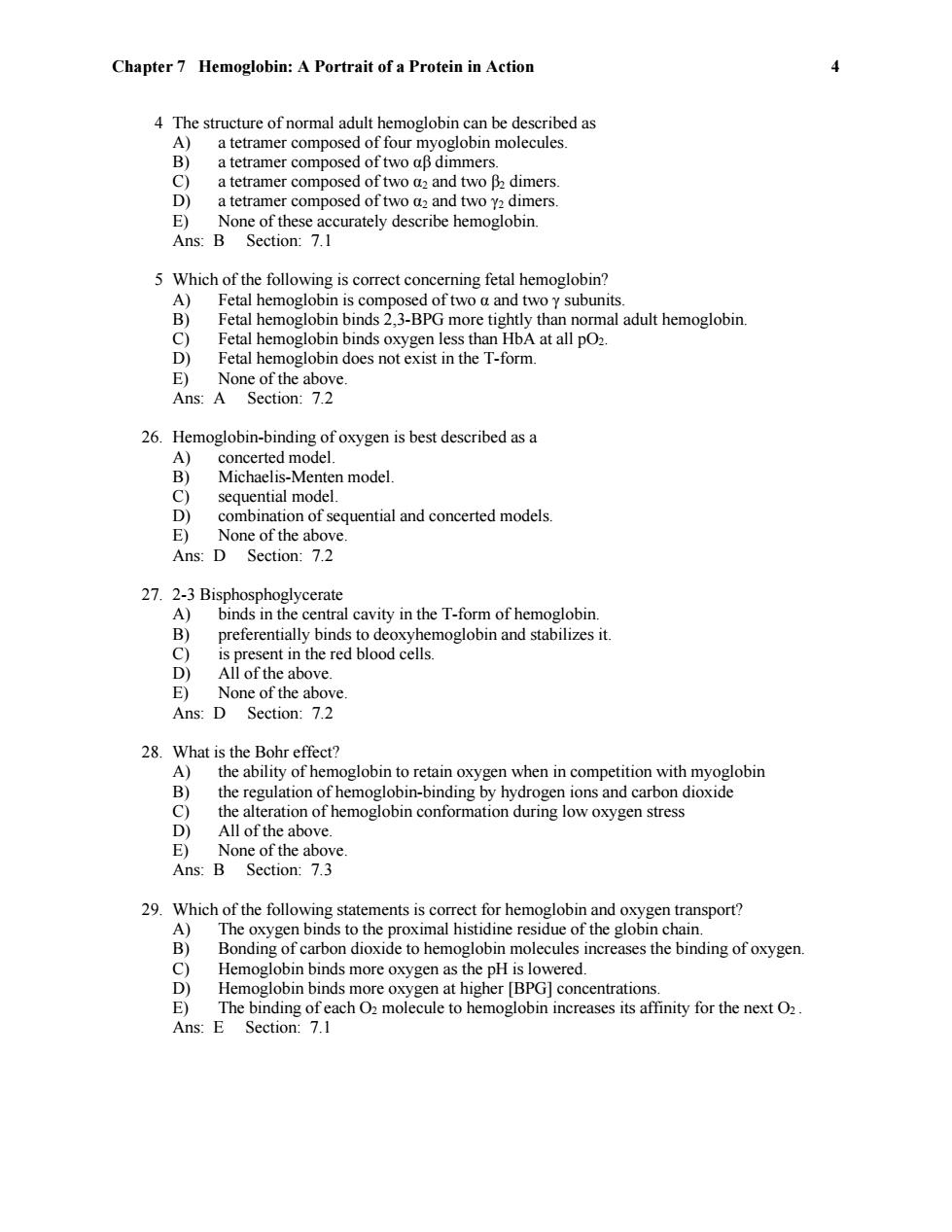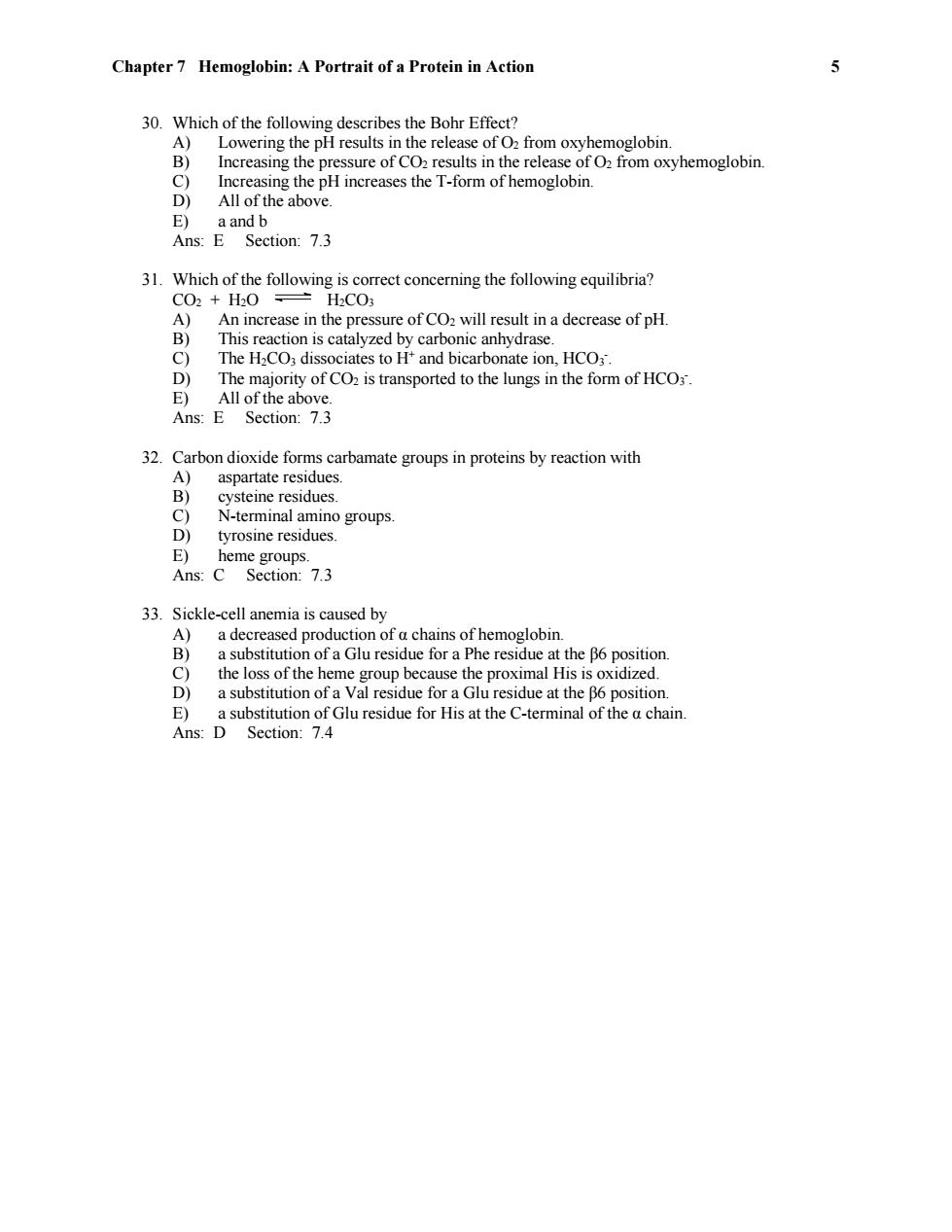
Chapter 7 Hemoglobin:A Portrait of a Protein in Action Matching Questions Use the following to answer questions 1-10: Choose the correct answer from the list below.Not all of the answers will be used a)cooperative b)Bohr effect c)thalassemia d)carbamate e)metmyoglobin f)superoxide g)myoglobin h)bicarbonate ion i)sickle-cell anemia j)protoporphyrin k)fetal 1)carbonic acid This is a reactive oxygen species that is damaging to biological materials. Ans:f Section:7.1 2 This is the organic portion of the heme group in hemoglobin. Ans:j Section:7.1 This is a genetic disease due to the decreased production of one of the subunits of hemoglobin. Ans:c Section:7.4 This is the chemical form in which most of the carbon dioxide is transported in the blood Ans:h Section:7.3 5 This substance is produced when carbon dioxide reacts with water. Ans:I Section:7.3
Chapter 7 Hemoglobin: A Portrait of a Protein in Action Matching Questions Use the following to answer questions 1-10: Choose the correct answer from the list below. Not all of the answers will be used. a) cooperative b) Bohr effect c) thalassemia d) carbamate e) metmyoglobin f) superoxide g) myoglobin h) bicarbonate ion i) sickle-cell anemia j) protoporphyrin k) fetal l) carbonic acid 1 ____________ This is a reactive oxygen species that is damaging to biological materials. Ans: f Section: 7.1 2 ____________ This is the organic portion of the heme group in hemoglobin. Ans: j Section: 7.1 3 ____________ This is a genetic disease due to the decreased production of one of the subunits of hemoglobin. Ans: c Section: 7.4 4 ____________ This is the chemical form in which most of the carbon dioxide is transported in the blood. Ans: h Section: 7.3 5 ____________ This substance is produced when carbon dioxide reacts with water. Ans: l Section: 7.3

Chapter 7 Hemoglobin:A Portrait of a Protein in Action 2 6 This type of hemoglobin is composed of two a chains and two y chains. Ans:k Section:7.2 7 This is the molecule whose function is to store oxygen is muscle cells. Ans:g Section:Introduction This oxidized hemeprotein does not reversibly bind oxygen. Ans:e Section:7.1 9 This type of binding is indicated by a sigmoidal-shaped binding curve. Ans:a Section:7.2 10 This condition is a result of a single point mutation in the B chain of hemoglobin. Ans:i Section:7.4 Fill in the Blank Questions 1 Under normal conditions,the heme iron in myoglobin and hemoglobin is in the oxidation state. Ans:ferrous,or Fe+2 Section:7.1 2 The ability of myoglobin to bind oxygen depends on the presence of a bound prosthetic group called Ans:heme Section:7.1 3 In hemoglobin,the iron of the heme is bonded to the four nitrogens of porphyrin and to the proximal residue of the globin chain. Ans:histidine Section:7.1 4 The binding of 2-3-bisphosphogycerate to hemoglobin (increases,decreases)its affinity of oxygen binding. Ans:decreases Section:7.2 5 The effect of pH on oxygen-binding of hemoglobin is referred to as the Ans:Bohr effect Section:7.3 6 Carbon dioxide reacts with the amino terminal groups of hemoglobin to form carbamate groups, which carry a. charge. Ans:negative Section:7.3
Chapter 7 Hemoglobin: A Portrait of a Protein in Action 2 6 ____________ This type of hemoglobin is composed of two α chains and two γ chains. Ans: k Section: 7.2 7 ____________ This is the molecule whose function is to store oxygen is muscle cells. Ans: g Section: Introduction 8 ____________ This oxidized hemeprotein does not reversibly bind oxygen. Ans: e Section: 7.1 9 ____________ This type of binding is indicated by a sigmoidal-shaped binding curve. Ans: a Section: 7.2 10 ____________ This condition is a result of a single point mutation in the β chain of hemoglobin. Ans: i Section: 7.4 Fill in the Blank Questions 1 Under normal conditions, the heme iron in myoglobin and hemoglobin is in the ____________ oxidation state. Ans: ferrous, or Fe +2 Section: 7.1 2 The ability of myoglobin to bind oxygen depends on the presence of a bound prosthetic group called _____________. Ans: heme Section: 7.1 3 In hemoglobin, the iron of the heme is bonded to the four nitrogens of porphyrin and to the proximal ______________ residue of the globin chain. Ans: histidine Section: 7.1 4 The binding of 2-3-bisphosphogycerate to hemoglobin ____________ (increases, decreases) its affinity of oxygen binding. Ans: decreases Section: 7.2 5 The effect of pH on oxygen-binding of hemoglobin is referred to as the _____________. Ans: Bohr effect Section: 7.3 6 Carbon dioxide reacts with the amino terminal groups of hemoglobin to form carbamate groups, which carry a ______________ charge. Ans: negative Section: 7.3

Chapter 7 Hemoglobin:A Portrait of a Protein in Action 3 7 The T-state of hemoglobin is stabilized by a salt bridge between Bi Asp 94 and the C-terminal of the Bi chain. Ans:histidine Section:7.3 8 In normal adult hemoglobin,HbA,the B6 position is a glutamate residue,whereas in sickle-cell hemoglobin,HbS,it is a residue. Ans:valine Section:7.4 9 As the pressure of carbon increases,the affinity of oxygen binding to hemoglobin Ans:decreases Section:7.3 10 2,3-Bisphosphoglycerate binds only to the form of hemoglobin. Ans:T-,or deoxy Section:7.2 Multiple Choice Questions 1 What factor(s)influence(s)the binding of oxygen to myoglobin? A)The concentration of bicarbonate ion,HCO3 B) The partial pressure of oxygen,pO2 C) The concentration of hemoglobin present D The concentration of 2,3-BPG E) Responses b and d Ans:B Section:7.1 2 Which of the following is correct concerning the differences between hemoglobin and myoglobin? A)Both hemoglobin and myoglobin are tetrameric proteins. B) Hemoglobin exhibits a hyperbolic O2 saturation curve while myoglobin exhibits a sigmoid shaped curve. C) Hemoglobin exhibits cooperative binding of O2 while myoglobin does not. D) Hemoglobin exhibits a higher degree of O2 saturation at all physiologically relevant partial pressures of O2 than does myoglobin. E) All of the above. Ans:C Section:7.1 3 Which of the following is not correct concerning myoglobin? A)The globin chain contains an extensive a-helix structure. B) The heme group is bound to the globin chain by two disulfide bonds to cysteine residues C)The iron of the heme group is in the Fe+2 oxidation state. D)The diameter of the iron ion decreases upon binding to oxygen. E)The function of myoglobin is oxygen storage in muscle. Ans:B Section:7.1
Chapter 7 Hemoglobin: A Portrait of a Protein in Action 3 7 The T-state of hemoglobin is stabilized by a salt bridge between β1 Asp 94 and the C-terminal ___________________ of the β1 chain. Ans: histidine Section: 7.3 8 In normal adult hemoglobin, HbA, the β6 position is a glutamate residue, whereas in sickle-cell hemoglobin, HbS, it is a ____________ residue. Ans: valine Section: 7.4 9 As the pressure of carbon increases, the affinity of oxygen binding to hemoglobin ______________. Ans: decreases Section: 7.3 10 2,3-Bisphosphoglycerate binds only to the __________________ form of hemoglobin. Ans: T-, or deoxy Section: 7.2 Multiple Choice Questions 1 What factor(s) influence(s) the binding of oxygen to myoglobin? A) The concentration of bicarbonate ion, HCO3 - B) The partial pressure of oxygen, pO2 C) The concentration of hemoglobin present D) The concentration of 2,3-BPG E) Responses b and d Ans: B Section: 7.1 2 Which of the following is correct concerning the differences between hemoglobin and myoglobin? A) Both hemoglobin and myoglobin are tetrameric proteins. B) Hemoglobin exhibits a hyperbolic O2 saturation curve while myoglobin exhibits a sigmoid shaped curve. C) Hemoglobin exhibits cooperative binding of O2 while myoglobin does not. D) Hemoglobin exhibits a higher degree of O2 saturation at all physiologically relevant partial pressures of O2 than does myoglobin. E) All of the above. Ans: C Section: 7.1 3 Which of the following is not correct concerning myoglobin? A) The globin chain contains an extensive α-helix structure. B) The heme group is bound to the globin chain by two disulfide bonds to cysteine residues C) The iron of the heme group is in the Fe +2 oxidation state. D) The diameter of the iron ion decreases upon binding to oxygen. E) The function of myoglobin is oxygen storage in muscle. Ans: B Section: 7.1

Chapter 7 Hemoglobin:A Portrait of a Protein in Action 4 4 The structure of normal adult hemoglobin can be described as A)a tetramer composed of four myoglobin molecules. B) a tetramer composed of two aB dimmers. c) a tetramer composed of two a2 and two B2 dimers. D) a tetramer composed of two a2 and two y2 dimers. E)None of these accurately describe hemoglobin. Ans:B Section:7.1 5 Which of the following is correct concerning fetal hemoglobin? A)Fetal hemoglobin is composed of two a and two y subunits B)Fetal hemoglobin binds 2,3-BPG more tightly than normal adult hemoglobin. C) Fetal hemoglobin binds oxygen less than HbA at all pO2. D) Fetal hemoglobin does not exist in the T-form. E)None of the above. Ans:A Section:7.2 26.Hemoglobin-binding of oxygen is best described as a A) concerted model. B) Michaelis-Menten model. C) sequential model. D) combination of sequential and concerted models E) None of the above. Ans:D Section:7.2 27.2-3 Bisphosphoglycerate A) binds in the central cavity in the T-form of hemoglobin. B) preferentially binds to deoxyhemoglobin and stabilizes it. C) is present in the red blood cells. D) All of the above. E)None of the above. Ans:D Section:7.2 28.What is the Bohr effect? A)the ability of hemoglobin to retain oxygen when in competition with myoglobin B)the regulation of hemoglobin-binding by hydrogen ions and carbon dioxide C) the alteration of hemoglobin conformation during low oxygen stress D) All of the above. E)None of the above. Ans:B Section:7.3 29.Which of the following statements is correct for hemoglobin and oxygen transport? A)The oxygen binds to the proximal histidine residue of the globin chain B) Bonding of carbon dioxide to hemoglobin molecules increases the binding of oxygen. C) Hemoglobin binds more oxygen as the pH is lowered. D) Hemoglobin binds more oxygen at higher [BPG]concentrations. E)The binding of each O2 molecule to hemoglobin increases its affinity for the next O2 Ans:E Section:7.1
Chapter 7 Hemoglobin: A Portrait of a Protein in Action 4 4 The structure of normal adult hemoglobin can be described as A) a tetramer composed of four myoglobin molecules. B) a tetramer composed of two αβ dimmers. C) a tetramer composed of two α2 and two β2 dimers. D) a tetramer composed of two α2 and two γ2 dimers. E) None of these accurately describe hemoglobin. Ans: B Section: 7.1 5 Which of the following is correct concerning fetal hemoglobin? A) Fetal hemoglobin is composed of two α and two γ subunits. B) Fetal hemoglobin binds 2,3-BPG more tightly than normal adult hemoglobin. C) Fetal hemoglobin binds oxygen less than HbA at all pO2. D) Fetal hemoglobin does not exist in the T-form. E) None of the above. Ans: A Section: 7.2 26. Hemoglobin-binding of oxygen is best described as a A) concerted model. B) Michaelis-Menten model. C) sequential model. D) combination of sequential and concerted models. E) None of the above. Ans: D Section: 7.2 27. 2-3 Bisphosphoglycerate A) binds in the central cavity in the T-form of hemoglobin. B) preferentially binds to deoxyhemoglobin and stabilizes it. C) is present in the red blood cells. D) All of the above. E) None of the above. Ans: D Section: 7.2 28. What is the Bohr effect? A) the ability of hemoglobin to retain oxygen when in competition with myoglobin B) the regulation of hemoglobin-binding by hydrogen ions and carbon dioxide C) the alteration of hemoglobin conformation during low oxygen stress D) All of the above. E) None of the above. Ans: B Section: 7.3 29. Which of the following statements is correct for hemoglobin and oxygen transport? A) The oxygen binds to the proximal histidine residue of the globin chain. B) Bonding of carbon dioxide to hemoglobin molecules increases the binding of oxygen. C) Hemoglobin binds more oxygen as the pH is lowered. D) Hemoglobin binds more oxygen at higher [BPG] concentrations. E) The binding of each O2 molecule to hemoglobin increases its affinity for the next O2 . Ans: E Section: 7.1

Chapter 7 Hemoglobin:A Portrait of a Protein in Action 30.Which of the following describes the Bohr Effect? A) Lowering the pH results in the release of O2 from oxyhemoglobin. B) Increasing the pressure of CO2 results in the release of O2 from oxyhemoglobin. c) Increasing the pH increases the T-form of hemoglobin. D) All of the above. E)a and b Ans:E Section:7.3 31.Which of the following is correct concerning the following equilibria? C02+H20=H2CO3 A)An increase in the pressure of CO2 will result in a decrease of pH. B This reaction is catalyzed by carbonic anhydrase. C) The H2CO3 dissociates to H'and bicarbonate ion,HCO3. D) The majority of CO2 is transported to the lungs in the form of HCO3. E) All of the above. Ans:E Section:7.3 32.Carbon dioxide forms carbamate groups in proteins by reaction with A)aspartate residues. B) cysteine residues. C) N-terminal amino groups. D) tyrosine residues. E) heme groups. Ans:C Section:7.3 33.Sickle-cell anemia is caused by A) a decreased production of a chains of hemoglobin. B) a substitution of a Glu residue for a Phe residue at the B6 position. C)the loss of the heme group because the proximal His is oxidized. D) a substitution of a Val residue for a Glu residue at the B6 position. E)a substitution of Glu residue for His at the C-terminal of the a chain. Ans:D Section:7.4
Chapter 7 Hemoglobin: A Portrait of a Protein in Action 5 30. Which of the following describes the Bohr Effect? A) Lowering the pH results in the release of O2 from oxyhemoglobin. B) Increasing the pressure of CO2 results in the release of O2 from oxyhemoglobin. C) Increasing the pH increases the T-form of hemoglobin. D) All of the above. E) a and b Ans: E Section: 7.3 31. Which of the following is correct concerning the following equilibria? CO2 + H2O H2CO3 A) An increase in the pressure of CO2 will result in a decrease of pH. B) This reaction is catalyzed by carbonic anhydrase. C) The H2CO3 dissociates to H+ and bicarbonate ion, HCO3 -. D) The majority of CO2 is transported to the lungs in the form of HCO3 -. E) All of the above. Ans: E Section: 7.3 32. Carbon dioxide forms carbamate groups in proteins by reaction with A) aspartate residues. B) cysteine residues. C) N-terminal amino groups. D) tyrosine residues. E) heme groups. Ans: C Section: 7.3 33. Sickle-cell anemia is caused by A) a decreased production of α chains of hemoglobin. B) a substitution of a Glu residue for a Phe residue at the β6 position. C) the loss of the heme group because the proximal His is oxidized. D) a substitution of a Val residue for a Glu residue at the β6 position. E) a substitution of Glu residue for His at the C-terminal of the α chain. Ans: D Section: 7.4